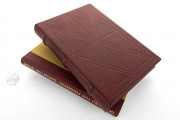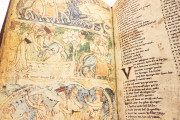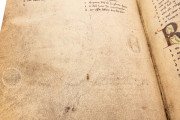The Munich manuscript of the Romance of Tristan and Isolde, written and illuminated toward the middle of the thirteenth century, contains Gottfried von Strassburg’s Arthurian tale. It is the earliest surviving copy of the poem. The tragic story of the two lovers is considered a key contributor to the Western notion of romantic love. The manuscript, produced in either France or Southern Germany, boasts thirty pages (fifteen leaves painted front and back) of stylistically dynamic figural illustrations on colored backgrounds, with each full-page miniature having two or three horizontal registers.
The book narrates the adulterous love between knight Tristan (Tristram) and the Irish princess Isolde (called Iseult or Yseult in other traditions). The well known story tells that the Cornish knight Tristan went to Ireland to bring back Isolde for his uncle Mark to marry. Along the way, both Tristan and Isolde took a love potion which caused the couple to fall in love. Although Isolde married Mark, the potion forced Tristan and Isolde to seek each other as lovers. There was no happy conclusion for the couple. Each one of the lovers died thinking that the beloved one was in love with someone else.
The narrative most likely influenced the Arthurian romance of Lancelot and Guinevere having important impact on Western art and the idea of romantic love since it first appeared in the twelfth century. While the romance was transmitted in several different traditions, the overall structure remained the same throughout the centuries.
The Earliest Known Manuscript of Gottfried Von Strassburg's Tristan and Isolde
Written in the second quarter of the thirteenth century and illustrated not much later, the significance of this manuscript containing the story of Tristan and Isolde depends on the fact that the volume in Munich is the earliest known copy. Produced in France or in southern Germany, the codex contains Gottfried von Strassburg's Tristan along with Ulrich von Türheim's continuation.
This manuscript presents miniatures that unfold the narrative in a picture book, employing a rare illustration technique for the romances of the thirteenth century. Systematic illustration of assorted vernacular texts remains sporadic well into the thirteenth century, when the French and Norman west very quickly develops its own splendid tradition of romance illustration.
A Romance in Pictures
The Individual scenes are organized on two registers and continue throughout the book. Refined painted pen drawings represent the story of Tristan and Isolde in picture strips. The illuminations do not accompany or punctuate the narrative; they gather more passages contracting episodes from the surrounding text. After the loss of possibly one or two painted pages, fifteen remain today. These few pages illustrate more than one hundred episodes of Tristan. The narrative unfolds throughout the manuscript highlighting certain values of extreme importance in chivalric literature, such as honor and love.
Probably two or three illuminators were at work for realizing this manuscript. Their style is quite homogeneous and it is characterized by figures with thin limbs and curly hair; they are dressed in contemporary clothes. Featured before colored backgrounds, the characters show elegant moves and gestures. Written in two columns, the text in Gothic cursive presents letters small in size but easily legible. Divisions of the text are marked with colored initials.
We have 1 facsimile edition of the manuscript "Romance of Tristan and Isolde": Gottfried von Strassburg: Tristan und Isolde facsimile edition, published by Mueller & Schindler, 1979
Request Info / Price























